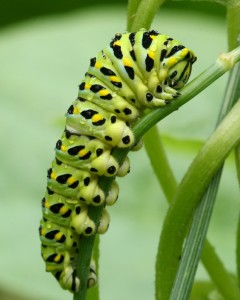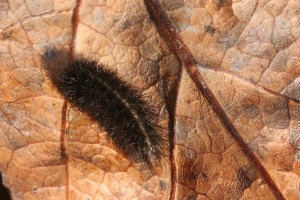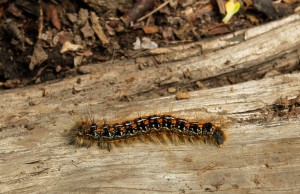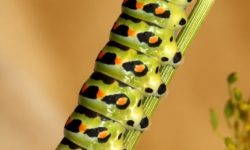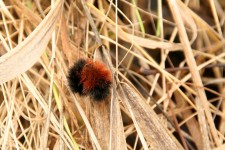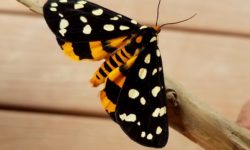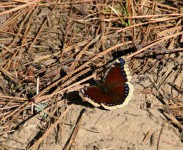As a slow-moving, plump morsel, caterpillars are an ideal target for a predator’s meal. However, caterpillars still exist because they have developed means to escape detection from predators or ward off predators.
The most common way caterpillars, like many other animals, escape detection is camouflage. Their camouflage makes it hard for even us to find them when they resemble twigs, bark, leaves, buds, flowers, fruits and tendrils. Larvae of several swallowtail butterfly even resemble bird droppings–something even birds won’t touch. Others bear false eyespots that resemble snake’s eyes or look like hair balls or small furry mammals.
Another way caterpillars escape detection is by not being exposed. They gain protection by living concealed lives within stems, roots, galls, seeds, wood and other plant tissue. Tent caterpillars build silk tents to help protect themselves from hungry birds. Tent caterpillars also find safety in numbers.
On the other end of the spectrum are caterpillars that are brightly colored and say “See me!” The black and yellow stripes of the black swallowtail caterpillar are easy to spot in the garden but birds have learned to avoid them. The bright colors are a warning to alert predators of the unpleasant taste or toxicity of the caterpillar. Black and yellow are two of nature’s most widespread warning colors as demonstrated with wasps and bees.
Monarch butterflies advertise their distastefulness with their black and orange coloration. They obtain this distastefulness during their larval stage when the caterpillar eats milkweed and retains the toxins.
Caterpillars can either obtain their toxicity from the plants they eat or they can manufacture the toxic compounds themselves.
If taste isn’t bad enough, one caterpillar wards off predators with its bad breath! The tobacco hornworm dines on nicotine-containing plants and as a result has bad breath which keeps predators at bay.
Predators also tend to pass over caterpillars with hair or bristles–who would blame them. While some caterpillars are just hairy, like the woolly caterpillar, others have spines and barbs. Some caterpillars have urticating hairs which are hollow hairs that discharge a painful irritant when broken. The urticating hairs even cause irritation on curious humans.
Bristles and hair also deter parasitizing insects from laying eggs within the caterpillar and then upon hatching eating the caterpillar’s insides. The hair and bristles act as an armor against these insects since they seek out the caterpillar by smell.
If smell, coloration, bristles and hair don’t ward of predators, caterpillars often resort to thanatosis–playing dead. Have you ever touched a caterpillar and it has fallen to the ground? The caterpillar is playing dead and is hedging bets that if it remains motionless on the ground it may go undetected.
Caterpillars exhibit a wide array of physical, chemical and behavioral tactics to avoid being eaten. However, predators keep adapting their search techniques to these tactics and help keep the caterpillar population in check.

